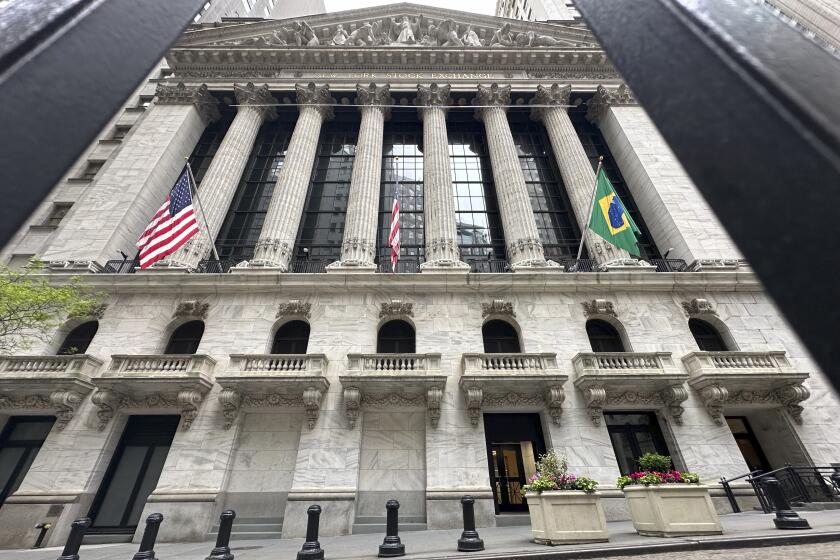Profit Taking Halts Dow Run; Dollar Surges
U.S. stocks ended mixed Wednesday as the steam ran out of this week’s rebound from last week’s deep slump.
Elsewhere, the dollar continued to strengthen, reaching a new 4 1/2-year high against the Japanese yen and a 37-month high against the German mark.
On Wall Street, the Dow Jones industrial average fell 45.32 points to 6,563.84, giving back most of Tuesday’s 53-point advance.
In the broad market, winners barely edged losers on the New York Stock Exchange and on Nasdaq, as buyers’ enthusiasm appeared to wane after three days of gains, while sellers continued to try to feed stock out.
The Nasdaq composite index fell 7.94 points to 1,249.43, its first loss in a week.
“You’ve got people doing some selling because they got a bounce off the lows on many stocks,” said Barry Berman, head trader for brokerage Robert W. Baird & Co. in Milwaukee.
Some analysts also have been disappointed because the market’s rebound from last week’s lows has been on relatively low trading volume--suggesting a lack of conviction on the part of buyers.
The Dow remains off 7.4% from its record high reached in mid-March; the Nasdaq index is down 10% from its peak.
Analysts say investors remain apprehensive because the economy’s strength is expected to compel the Federal Reserve Board to raise interest rates further. The Fed tightened credit March 25 for the first time in two years, triggering stocks’ slide.
Bond yields, which have soared in recent weeks, have hovered near seven-month highs over the last few sessions, awaiting additional clues about the economy.
The bellwether 30-year Treasury bond yield ended at 7.10% on Wednesday, unchanged from Tuesday.
The government in the days ahead will release figures on March wholesale inflation, retail sales and consumer inflation. “The onus is on the data to be weak for the Fed not to tighten,” said Bill Mast, bond strategist at Smith Barney Inc.
The only big beneficiary of the strong economy and higher interest rates so far has been the dollar.
In New York trading, the dollar reached its highest level against the Japanese yen since August 1992 before settling at 126.77 yen, up from 126.23 on Tuesday.
The dollar also hit 1.727 German marks, its highest level against the German currency since February 1994, before ending at 1.725 marks, up from 1.716 on Tuesday.
Higher U.S. interest rates make dollar-denominated securities more attractive for foreign investors, helping to drive the currency up.
But the dollar’s strength this week may stem largely from “a general belief that central banks are not going to be concerned about a move higher, so in the market’s mind they’ve gotten the green light to take it higher,” said Richard Vullo, a vice president at Bayerische Hypothenken und Weschelsbank.
U.S. and Japanese officials have signaled in recent days that they aren’t displeased with the stronger buck, which helps the still-struggling Japanese and German economies by reducing their exporters’ product prices in the United States.
At the same time, however, the stronger dollar makes it tougher for U.S. companies to compete with their Japanese and German peers.
That may be another handicap in the stock market’s struggle to get a rally going.
At least one survey shows investors becoming more bearish.
According to a newly released poll by financial services company Quick & Reilly, 39% of investors describe themselves as bullish, down from 58% in January.
Those expressing a bearish market outlook rose to 31%, up from 20% three months ago. The survey shows the prevailing investor mood as “conservatism rather than panic,” Quick & Reilly said.
Among Wednesday’s highlights:
* The financial and utility sectors--both sensitive to interest rates’ trend--were hit by sellers again.
J.P. Morgan sank 3 to 98 3/8, Wells Fargo lost 8 1/4 to 276, NationsBank dropped 1 3/8 to 57 1/4 and Citicorp was off 1 7/8 to 112 7/8.
Electric utilities also lost ground, driving the Standard & Poor’s electric-stock index down to its lowest level since May 1995. (Investor Spotlight, D8.)
* The Dow’s decline was paced by Merck, which slumped 3 3/4 to 81 1/2 on concern that its best-selling cholesterol drugs are losing market share to a new medication from Warner-Lambert, which rose 1 3/8 to 94 7/8. Several brokerages downgraded their rating of Merck stock.
Other drug issues sliding included Eli Lilly, down 2 5/8 to 79 7/8; Pfizer, down 1 7/8 to 84 1/8; and Schering-Plough, off 1 3/8 to 72 3/4.
* IBM, the Dow’s strongest issue in the previous two sessions, pulled back sharply, falling 3 1/2 to 133 1/8.
Many other tech issues also sank, including disk drive maker Seagate, which fell 2 5/8 to 49 3/8 despite reporting first-quarter earnings well above expectations.
PairGain Technologies fell 2 7/8 to 27 in after-hours trading. After the market closed it reported quarterly earnings up 67%, slightly short of expectations.
Other tech losers included Intel, down 4 23/64 to 142 1/4; Micron, down 2 to 41 3/8; and BMC Software, down 3 1/8 to 44 5/8.
* Procter & Gamble jumped 4 to 199 3/4 on news it was acquiring Tampax tampon maker Tambrands for $1.85 billion, or $50 a share. Tambrands rose 2 to 48 1/2.
* Also on the plus side, some retailers continued to rally, taking a cue from the economy’s strength. Tandy rose 1 3/4 to 53, Home Depot added 1 to 56 7/8, Pier One added 3/8 to 18 1/4 and Ross Stores gained 1/2 to 27 3/4.
Overseas, Tokyo’s Nikkei stock average fell 1.8%, Frankfurt’s DAX index rose 0.9% and London’s FTSE-100 rose 0.5%.






